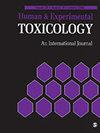CircRNA_001373 promotes liver fibrosis by regulating autophagy activation in hepatic stellate cells via the miR-142a-5p/Becn1 axis
IF 2.7
4区 医学
Q3 TOXICOLOGY
引用次数: 0
Abstract
The purpose of this study was to investigate the regulatory role and underlying mechanisms of circRNA_001373 in the hepatic stellate cell (HSC) activation. Quantitative real-time polymerase chain reaction was used to detect the expression of circRNA_001373, miR-142a-5p and Becn1. The viability of JS-1 cells was measured by Cell Counting Kit-8. The targeting relationship between miR-142a-5p and CircRNA_001373, as well as between miR-142a-5p and Becn1 was predicted using CircInteractome and TargetScan databases, respectively, and validated by dual-luciferase reporter assay. Western blot was utilized to determine the expression levels of proteins related to autophagy and the activation if HSCs in JS-1 cells. After activation by platelet-derived growth factor-BB, an increase was observed in the expression of collagen I and α-smooth muscle actin proteins. The expression of CircRNA_001373 was up-regulated in the activated HSCs. Knockdown of CircRNA_001373 significantly inhibited cell viability and activation of JS-1 cells, as well as autophagy in the activated HSCs. CircRNA_001373 could sponge miR-142a-5p in the activated HSCs, which in turn elevated the Becn1 expression. Concurrent knockdown of both CircRNA_001373 and miR-142a-5p reversed the inhibitory effects of the knockdown of CircRNA_001373 alone on cell viability and autophagy in activated JS-1 cells. CircRNA_ 001373 promotes cell viability and autophagy as well as the activation of JS-1 cells by regulating the miR-142a-5p/Becn1 axis.CircRNA_001373通过miR-142a-5p/Becn1轴调节肝星状细胞的自噬激活,从而促进肝纤维化
本研究旨在探讨circRNA_001373在肝星状细胞(HSC)活化过程中的调控作用及其内在机制。研究采用定量实时聚合酶链反应检测circRNA_001373、miR-142a-5p和Becn1的表达。用细胞计数试剂盒-8测定了JS-1细胞的活力。利用 CircInteractome 和 TargetScan 数据库分别预测了 miR-142a-5p 与 CircRNA_001373 之间以及 miR-142a-5p 与 Becn1 之间的靶向关系,并通过双荧光素酶报告实验进行了验证。利用Western印迹法测定了JS-1细胞中与自噬和造血干细胞活化有关的蛋白质的表达水平。经血小板衍生生长因子-BB激活后,观察到胶原蛋白I和α-平滑肌肌动蛋白的表达增加。在活化的造血干细胞中,CircRNA_001373的表达上调。敲除CircRNA_001373能显著抑制JS-1细胞的活力和活化,并抑制活化的造血干细胞的自噬。CircRNA_001373能在活化的造血干细胞中海绵化miR-142a-5p,进而提高Becn1的表达。同时敲除CircRNA_001373和miR-142a-5p可逆转单独敲除CircRNA_001373对活化的JS-1细胞活力和自噬的抑制作用。CircRNA_001373通过调节miR-142a-5p/Becn1轴促进细胞活力和自噬以及活化JS-1细胞。
本文章由计算机程序翻译,如有差异,请以英文原文为准。
求助全文
约1分钟内获得全文
求助全文
来源期刊
CiteScore
5.70
自引率
3.60%
发文量
128
审稿时长
2.3 months
期刊介绍:
Human and Experimental Toxicology (HET), an international peer reviewed journal, is dedicated to publishing preclinical and clinical original research papers and in-depth reviews that comprehensively cover studies of functional, biochemical and structural disorders in toxicology. The principal aim of the HET is to publish timely high impact hypothesis driven scholarly work with an international scope. The journal publishes on: Structural, functional, biochemical, and molecular effects of toxic agents; Studies that address mechanisms/modes of toxicity; Safety evaluation of novel chemical, biotechnologically-derived products, and nanomaterials for human health assessment including statistical and mechanism-based approaches; Novel methods or approaches to research on animal and human tissues (medical and veterinary patients) investigating functional, biochemical and structural disorder; in vitro techniques, particularly those supporting alternative methods

 求助内容:
求助内容: 应助结果提醒方式:
应助结果提醒方式:


